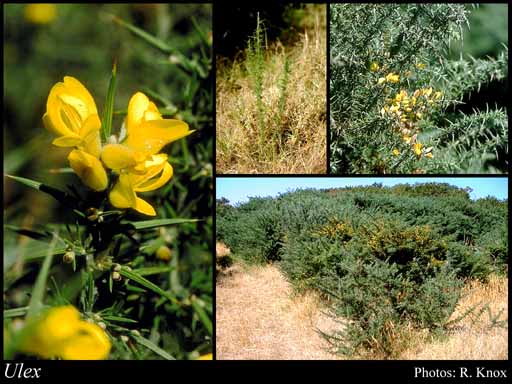- Reference
- Sp.Pl. [Linnaeus] 2:741 (1753)
- Name Status
- Current

Scientific Description
Family Papilionaceae. Genisteae.
Habit and leaf form. Heavily armed, small shrubs; not resinous. Switch-plants; with the principal photosynthesizing function transferred to stems and phyllodineous. Leaves well developed and much reduced (normal only on young plants, branched phyllode spines and scales on mature plants). Plants spiny. The spines axial and foliar. Xerophytic. Phyllodes modified into spines. Heterophyllous (scales, phyllodes, trifoliolate leaves). Leaves minute to medium-sized; alternate; spiral; with blades, or bladeless; membranous and modified into spines; subsessile to sessile; non-sheathing; edgewise to the stem, or with ‘normal’ orientation; simple (or ‘reduced’), or compound (on young plants only); pulvinate to epulvinate; on young plants, ternate. Leaves palmately trifoliolate. Leaflets 0, or 3. Leaves without stipules; without a persistent basal meristem. Stem anatomy. Secondary thickening developing from a conventional cambial ring.
Reproductive type, pollination. Fertile flowers hermaphrodite. Unisexual flowers absent. Plants hermaphrodite. Entomophilous.
Inflorescence and flower features. Flowers solitary, or aggregated in ‘inflorescences’; not crowded at the stem bases; when solitary, axillary; when agregated, in racemes. Inflorescences simple, or compound. The terminal inflorescence unit racemose. Flowers shortly pedicellate; bracteate (small); bracteolate (small and broad, under the calyx), or ebracteolate. Bracteoles adnate to the receptacle, or not adnate to the receptacle. Flowers small to medium-sized; fragrant; very irregular; zygomorphic. The floral asymmetry involving the perianth and involving the androecium. Flowers papilionaceous (imbricate-descending, with the posterior petal outside and forming a ‘standard’); basically 5 merous. Floral receptacle with neither androphore nor gynophore. Free hypanthium present, or absent. Perianth with distinct calyx and corolla; 10; 2 -whorled; isomerous. Calyx present; 5; 1 -whorled; gamosepalous; (five) lobed; imbricate, or valvate; exceeded by the corolla; deeply bilabiate (the posterior lip minutely 2-toothed, the anterior minutely 3-toothed); yellow; non-fleshy (membranous); persistent; non-accrescent; with the median member anterior. Corolla present; 5; 1 -whorled; appendiculate, or not appendiculate. Standard not appendaged. Corolla partially gamopetalous. 2 of the petals joined (the two ventral petals connivent to form the ‘keel’, the wings free of oneanother). The joined petals anterior. The wings of the corolla free from the keel; not laterally spurred. Standard ‘normally’ developed (ovate); not sericeous. Keel about equalling the wings (the petals subequal, the keel straight beneath); not long-acuminate/beaked (blunt); neither coiled nor spiralled; not bent and beaked. Corolla imbricate (descending); plain; yellow; persistent, or deciduous; non-accrescent. Petals shortly clawed. Androecial members definite in number. Androecium 10. Androecial sequence determinable, or not determinable. Androecial members free of the perianth; all equal, or markedly unequal; coherent (the filaments united basally into a closed tube); 1 - adelphous. The staminal tube free from the keel petals. Androecial members 1 -whorled. Androecium exclusively of fertile stamens. Stamens 10; distinctly dissimilar in shape (the anthers alternately long basifixed, short dorsifixed); diplostemonous; both opposite and alternating with the corolla members. Anthers separate from one another, or connivent; dimorphic (long-basifixed, short-dorsifixed); alternately dorsifixed and basifixed; alternately versatile and non-versatile; dehiscing via pores, or dehiscing via longitudinal slits; latrorse, or introrse; tetrasporangiate. Pollen shed as single grains. Gynoecium 1 carpelled. The pistil 1 celled. Carpels reduced in number relative to the perianth. Gynoecium monomerous; of one carpel; superior. Carpel stylate; apically stigmatic. Style upwardly, abruptly curved to hooked (at the tip). Style terete. Style glabrous. Stigmatic tissue terminal. Carpel 6–25 ovuled (i.e. ‘many’). Placentation marginal (along the ventral suture). Gynoecium median (the placenta posterior, on the ventral suture). Ovary sessile. Stigmas capitate. Ovules pendulous to ascending; biseriate; arillate; anatropous, or campylotropous to amphitropous, or hemianatropous.
Fruit and seed features. Fruit sessile; non-fleshy; not hairy. The fruiting carpel dehiscent; a legume. Pods somewhat elongated, or much elongated (ovate, oblong or shortly linear); not triangular; straight; not becoming inflated; somewhat compressed to terete; regularly constricted between adjacent seeds, or irregularly constricted, or not constricted between the seeds; not transversely septate; wingless. Valves of the dehisced pod twisted, or not twisted. Fruit 1 celled; elastically dehiscent. Dispersal unit the seed. Fruit 2–25 seeded. Seeds endospermic, or non-endospermic; not mucous; small to medium sized; arillate. Cotyledons 2; if radicle flexed, accumbent. Embryo chlorophyllous; straight, or curved, or bent. Testa non-operculate. Micropyle zigzag, or not zigzag. Seedling. Germination phanerocotylar, or cryptocotylar.
Physiology, biochemistry. Nitrogen-fixing root nodules present. Aluminium accumulation not found. Photosynthetic pathway: C3.
Geography, cytology, number of species. World distribution: W. Europe and N. Africa. Adventive. 2n=32, 64 (80) 96. A genus of 20 species; 1 species in Western Australia.